Venice in Winter
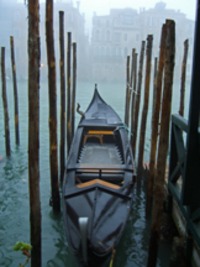 Venice is reborn at the beginning of every winter—which is why it’s our favorite time to visit. Summer's 5 am dawn and waning purple daylight as late as 10 pm, promote life in the campos--outdoor drinks and dining and shirt-sleeve strolling. When foggy first-light on the grand canal comes in the morning after eight, and squares and streets lit by shop lights and mist-haloed streetlights are in full dark before five, the streetscape becomes well-bundled shoppers and home-goers moving quickly from place to place, fogging breath into frigid air.
Venice is reborn at the beginning of every winter—which is why it’s our favorite time to visit. Summer's 5 am dawn and waning purple daylight as late as 10 pm, promote life in the campos--outdoor drinks and dining and shirt-sleeve strolling. When foggy first-light on the grand canal comes in the morning after eight, and squares and streets lit by shop lights and mist-haloed streetlights are in full dark before five, the streetscape becomes well-bundled shoppers and home-goers moving quickly from place to place, fogging breath into frigid air.
The biggest change for both winter visitors and residents is the great exodus of the summer tourists. There are about 80,000 permanent residents in Venice, and up to eight million summer visitors! Residents who regularly leave for the summer, and rent out their flats or apartments for tidy sums, return when the tide of humanity has receded. Visitors are mostly those people who can't bear the summer crowds, and like both the atmosphere of the city and the weather that a winter visit provides. The calles and alleys are un-crowded--the desertion of the streets in winter is magical. The hordes of shorts, t-shirt and backpack crowd, and 5-hour day-trippers disgorged by one or more behemoth cruise ships are gone. Strollers are swathed in long down coats, and when it’s near freezing, it seems like every third woman sports a long, elegant fur coat and hats or headbands to match.
This year we exited Marco Polo airport for a Christmas-New year's interregnum trip, into the freezing air for the ten-minute walk to the water taxi stand, and then the ten minutes in the icy wind over the lagoon to the island city. We were elated at another prospect of cold, quiet, relatively empty Venice. Even if we could afford suites at the Gritti, Daniele or Bauer Palazzo, we prefer to find interesting apartments to stay in Venice. We've thus lived all over the city, and this trip had found a small apartment in the grand old Palazzo Mocenigo directly on the Grand Canal. And I mean not only is the palace, but our very apartment right on the canal, at water level. Daniella, our representative from Truly Venice had opened the porta acqua--or water door--of the palace, situated right beside the entrance to our apartment, and waited on the private boat landing for our water taxi to disgorge our baggage and us directly into our accommodations. This is arriving in Venice in style!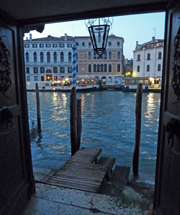
What shows as a large block labeled Palazzo Mocenigo on most maps, is in fact four separate palaces built at different times. The two palaces in the middle, in one of which sits our apartment, date to the second half of the sixteenth century. They are Palladian in style and were for a long time actually attributed to Palladio. Limestone floors, heavy chestnut-beamed ceilings and gleaming Venetian marble plaster walls define the 700 sq. ft. space. It's been fully modernized and furnished in a sort of eclectic-bohemian style: quasi antiques, crystal lamps, marble busts and lots of doge red. There are comfortable chairs and sofa, bookshelves along one wall full of books and collected objets. To the land side of our entrance, there is the main palazzo’s long beamed reception hall, which opens onto an inner courtyard lined with shrubs and towering trees, a very bucolic and eerily quiet space. The main iron and glass portal gives onto the narrow Calle Mocenigo Ca' Nuova that leads in 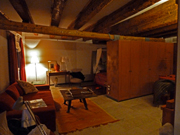 a few twists and turns up to my namesake Campo Santo Stefano.
a few twists and turns up to my namesake Campo Santo Stefano.
Weather, storms and tides affect life and getting around in a big way in this the season of acqua alta, which translates as high water. Depending on the confluence of moon, tides, weather, storms, and wind a few or a majority of the streets and alleys of Venice can be inundated to a couple of inches, or sometimes a couple of feet. Shoe shops and street vendors sell inexpensive rubber boots or booties that go on over your shoes to navigate the inches portions. For habitually deeper streets, the city keeps stacked sections of wood and metal platforms that create elevated walkways when erected--two people wide--one each way. Routes back from the restaurant or concert to the hotel or apartment have to be re-thought with the water changes in the intervening hours. On our very first experience with aqua alta many years ago, we returned from dinner to our hotel, the Flora. Completely unaware, we were first blocked by several inches of water in the street we'd come, mapped a workaround to find that more deeply flooded, and tried a third route to find it also immersed. Finally we had no choice but to take off shoes, roll up pant legs and dress and wade through the submerged  portion.
portion.
Venice anytime is a city for walking; for wandering; for often becoming lost; and for possibly arriving where you intended to go later than intended and by a different route. Or possibly becoming distracted by something you run across, and arriving at a different destination altogether. This wandering is much more enjoyable in winter when the city is no longer torrid, crammed with those millions of tourists who overwhelm it each year.
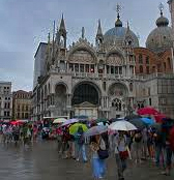 In winter the city is often a forest of umbrellas. Two lines of multl-colored canopies merge like a couple of caterpillars undulating up and over the canal bridges, or snaking along the raised platforms set in low areas if the acqua alta is in. Water and sky fade into each other, and the cityscape is an indistinct blur punctuated by haloed streetlights. But much of early winter is clear, if bitter cold. The sun is low and weak, but still turns the canals a brilliant grey-green, and highlights the facades of canal-side houses in buff stone, dusty rose, dull gold and ochre plaster. The Grand Canal stretches both directions into the distance, a magnificent line of mostly white ornate palaces with pillars and arched windows in the Venetian Gothic and Renaissance styles.
In winter the city is often a forest of umbrellas. Two lines of multl-colored canopies merge like a couple of caterpillars undulating up and over the canal bridges, or snaking along the raised platforms set in low areas if the acqua alta is in. Water and sky fade into each other, and the cityscape is an indistinct blur punctuated by haloed streetlights. But much of early winter is clear, if bitter cold. The sun is low and weak, but still turns the canals a brilliant grey-green, and highlights the facades of canal-side houses in buff stone, dusty rose, dull gold and ochre plaster. The Grand Canal stretches both directions into the distance, a magnificent line of mostly white ornate palaces with pillars and arched windows in the Venetian Gothic and Renaissance styles.
And then fog and mist will come in and shroud the city in mystery. Gondolas bob indistinctly between their blue and white barber-striped poles; water taxis appear out of and disappear into nothingness in the fog-swathed canals. The twisting calles and streets disappear into nebulousness, and the cacophony of church bells signaling the hours, or mass, are muted.
A rule of thumb for walking in Venice is the farther from San Marco Square, the less crowded. That is a maxim best not ignored in summer, but in winter, one can be in St Marks with only a smattering of visitors and Venetians--far fewer than the ubiquitous pigeons. One morning we wandered across the piazza in the wan sun, and found we could walk right into the Basilica San Marco to view its stunning Byzantine mosaics of St. John’s stories. And while the winding main shopping route from San Marco to the Rialto Bridge was not empty, it was far more passable than in June, when we'd avoid it like the plague. The Rialto market is a favorite location, and it’s bustling with Venetians buying beautiful tiny pink shrimp from the lagoon, brown spiny crabs, huge shells of scallops and silvery soglio and dentice for their holiday meals. The adjacent produce market is heaped with red and yellow peppers, huge heads of bitter puntarella, long red-striped Treviso radicchio, and artichokes of all sizes, pre-trimmed and floating in acidulated water. One vendor shouts in a cigarette-and-grappa-hoarsened voice "carciofi, carciofini, fonda di carciofi, tutti carciofi!"
and it’s bustling with Venetians buying beautiful tiny pink shrimp from the lagoon, brown spiny crabs, huge shells of scallops and silvery soglio and dentice for their holiday meals. The adjacent produce market is heaped with red and yellow peppers, huge heads of bitter puntarella, long red-striped Treviso radicchio, and artichokes of all sizes, pre-trimmed and floating in acidulated water. One vendor shouts in a cigarette-and-grappa-hoarsened voice "carciofi, carciofini, fonda di carciofi, tutti carciofi!"
 We visited Harry’s Bar several times for cocktails—which are absurdly expensive, but worth it. Sitting at the tiny six-seat granite bar, with head barman Claudio mixing up signature martinis and Bellinis in front of us, and with waiter and maitre d’ action swirling all around as guests arrive, we felt welcome and at home and part of the circle of locals and expats.
We visited Harry’s Bar several times for cocktails—which are absurdly expensive, but worth it. Sitting at the tiny six-seat granite bar, with head barman Claudio mixing up signature martinis and Bellinis in front of us, and with waiter and maitre d’ action swirling all around as guests arrive, we felt welcome and at home and part of the circle of locals and expats.
New Year’s Eve morning, we had learned about the annual Concerto di Capodanno at the Fenice opera house--one of the jewel-box opera houses in Italy, and a place we hadn't been into since well before the fire in 1996 and the ensuing 8-year restoration. So at 4 pm we were ensconced in the front row of box 6, second level of five that reach to the ceiling, looking directly down at the stage and orchestra and the sea of elegant, mostly older Venetians in the platea--or orchestra level. The annual concert is broadcast on Italian 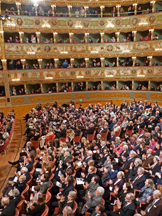 state radio and television—RAI and there were huge TV cameras in several boxes, two up in the orchestra, and a roaming cameraman with a hand-held down on the floor. Full orchestra in white tie and tails, full chorus, and the young English conductor Daniel Harding came on stage to tremendous applause. He proceeded to lead the orchestra through a powerful rendition of Dvorak’s New World Symphony, and after a break, with three lovely soloists and the chorus, a series of crowd-familiar opera pieces, including arias and duets from Figaro, Rigoletto, Barber of Seville, and Traviata.
state radio and television—RAI and there were huge TV cameras in several boxes, two up in the orchestra, and a roaming cameraman with a hand-held down on the floor. Full orchestra in white tie and tails, full chorus, and the young English conductor Daniel Harding came on stage to tremendous applause. He proceeded to lead the orchestra through a powerful rendition of Dvorak’s New World Symphony, and after a break, with three lovely soloists and the chorus, a series of crowd-familiar opera pieces, including arias and duets from Figaro, Rigoletto, Barber of Seville, and Traviata.
While not big year-end party people, we had booked dinner New Year’s Eve at Al Covo, a small and celebrated restaurant well into the eastern part of Castello, in the Campiello dela Pescaria. It was mentioned in a recent New York Times travel piece, featured in Tony Bourdain's No Reservations segment a year ago, and woven into one of Donna Leon's Inspector Brunetti Venetian mysteries (Leon and Diane Benelli, the Texan co-owner with husband Cesare are good friends). Dinner at A l Covo was many spaced-out courses of spectacular food. A fresh lobster tail with horseradish mayonnaise, a 'light' tartare of white Piemontese beef simply dressed with quail’s egg yolk and a snowfall of white truffles; a perfect crisp-fried San Pietro filet (John Dory to the English); and unctuously tender golf balls of beef cheek on lentil puree drizzled with a red-wine reduction. And for dessert with Champagne, as midnight approached, classic Venetian fried cream, and tender panattone covered in warm Marsala-redolent zabaglione.
l Covo was many spaced-out courses of spectacular food. A fresh lobster tail with horseradish mayonnaise, a 'light' tartare of white Piemontese beef simply dressed with quail’s egg yolk and a snowfall of white truffles; a perfect crisp-fried San Pietro filet (John Dory to the English); and unctuously tender golf balls of beef cheek on lentil puree drizzled with a red-wine reduction. And for dessert with Champagne, as midnight approached, classic Venetian fried cream, and tender panattone covered in warm Marsala-redolent zabaglione.
We headed for San Marco along the riva as midnight approached, to catch the fireworks in the Bacino San Marco, but the closer we got the thicker and uglier the crowds got. It began to feel like crushing or trampling was an actual possibility, so we headed into the back streets, and wound our way eventually back the calm of our quarter and our wonderful canal-front apartment. A final nightcap to celebrate the New Year, and we splattered onto the bed around 2 am.
In the New Year, we booked a table one evening at A Beccafico in Campo Santo Stefano--recommended highly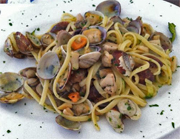 by Daniella. A tiny, elegant and modern restaurant, the place was packed to the gills with characters from central casting when we arrived at 9: a perfect Venetian family out for Sunday dinner; a table with one handsome man and four gorgeous blonds, all mysteriously wearing what appeared to be red panties wrapped around their wrists--we speculate: old and new lovers, all gathered; a table for two off-the-runway dressed couples, one a model-perfect Venetian princess, with an emerald ring the size of a pigeon egg.
by Daniella. A tiny, elegant and modern restaurant, the place was packed to the gills with characters from central casting when we arrived at 9: a perfect Venetian family out for Sunday dinner; a table with one handsome man and four gorgeous blonds, all mysteriously wearing what appeared to be red panties wrapped around their wrists--we speculate: old and new lovers, all gathered; a table for two off-the-runway dressed couples, one a model-perfect Venetian princess, with an emerald ring the size of a pigeon egg.
The staff at Beccafico is formally dressed, clearly knows most of the people in the room, and couldn't have been friendlier to us--the only stragnieri in the place. The extensive menu is all in Italian, with only a short key page of basic terms to other languages--so it quite taxed our food Italian to order. Herbed flatbread and two crostini of Sicilian olive oil and peeled tomato were brought with the wine--a 2007 Planeta Burdese--cabernet/cabernet franc. We started with brica of ricotta and capers--brik dough cigared around the filling and deep fried, and a simple yet superb tangle of tempura vegetable shards--zucchini, onion, fennel, pepper and cauliflower. An order for Braciolette di agnello arrustuti brought five tiny perfectly grilled lamb chops, with a mound of eggplant done up like caponata. My linguine vongole veraci came with both flavorful clams and tiny mussels, and very al dente pasta all tossed with oil and a bit of shellfish juices. We were way too full for dessert, but Sicilian owner Adeli Beccafico insisted on treating us to an orange sorbet frozen into a half orange, accompanied by small bottles of both Sicilian moscato dessert wine and limoncello, from which to sample as we pleased.
We asked about the name of the restaurant, and he replied that it means a small bird which eats figs; and further that it refers to a traditional Sicilian dish where a split, boned sardine is spread with herbs, breadcrumbs pine nuts and raisins, closed and fried--"it curls head and tail and looks like the bird". As we 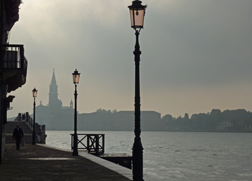 departed, he rushed out the door after us to present a small panettone - "for breakfast tomorrow" he said, "so you don't have to go out". That touch epitomized the attitude and welcome that can be part of visiting Venice in the winter—what better time to come?
departed, he rushed out the door after us to present a small panettone - "for breakfast tomorrow" he said, "so you don't have to go out". That touch epitomized the attitude and welcome that can be part of visiting Venice in the winter—what better time to come?